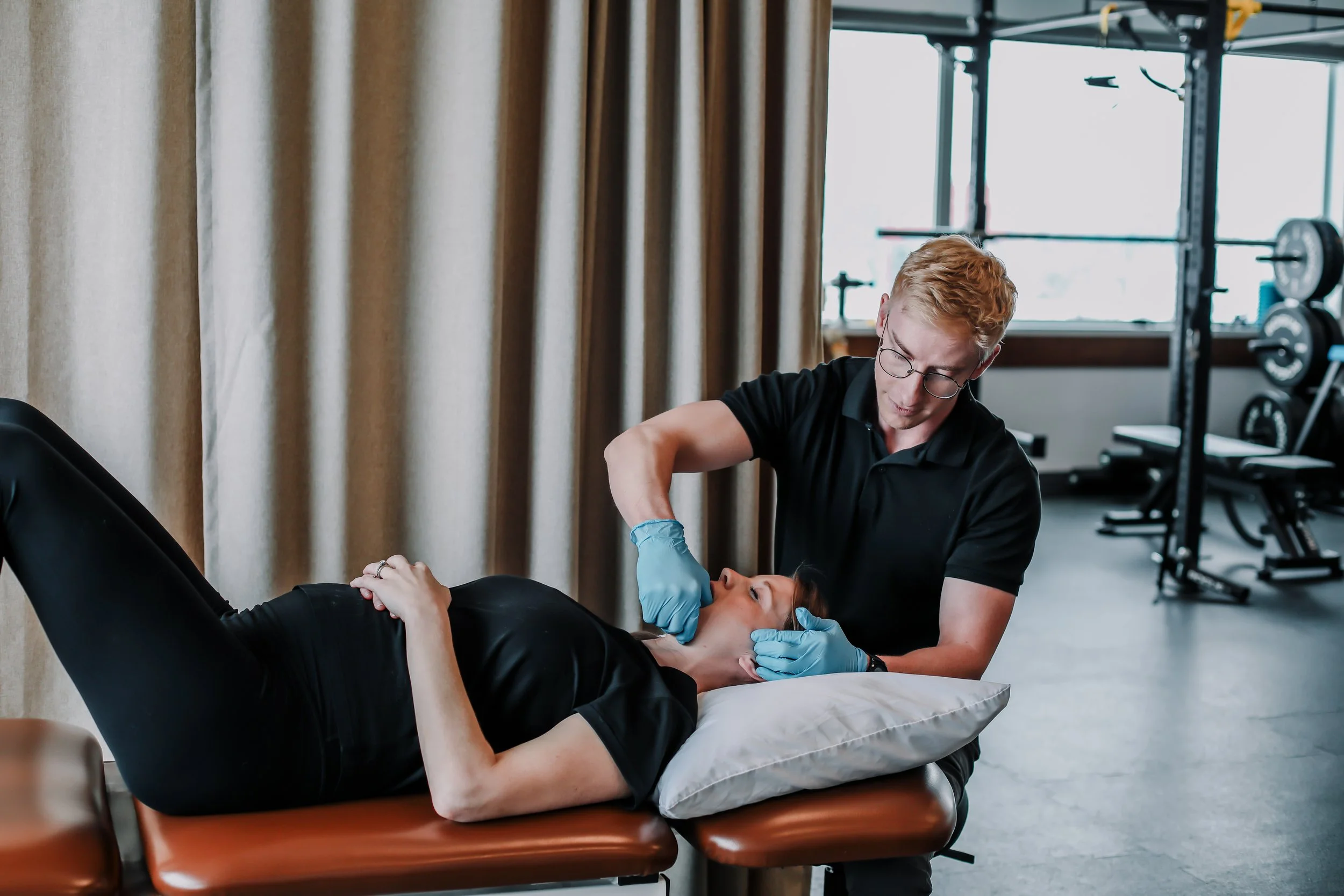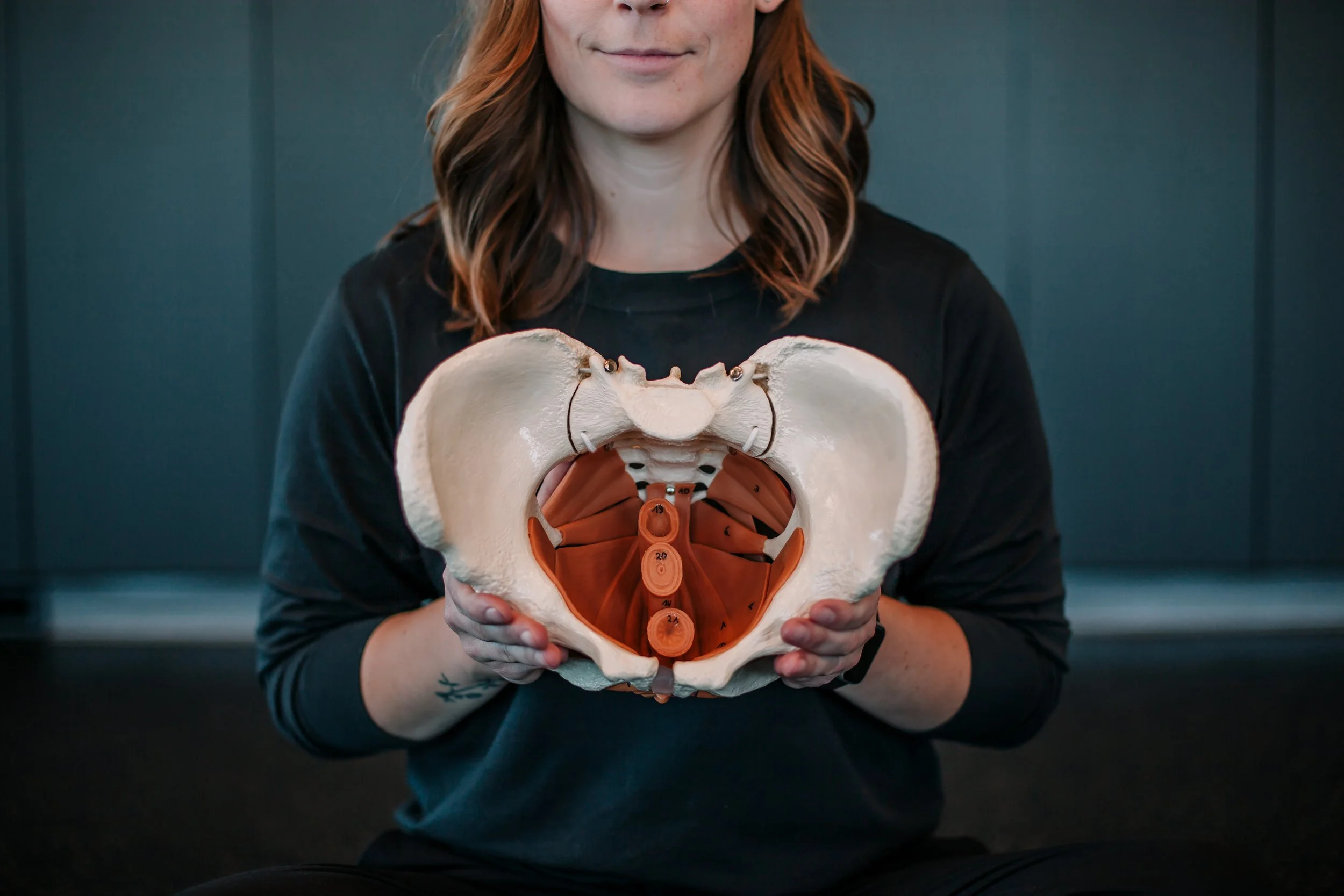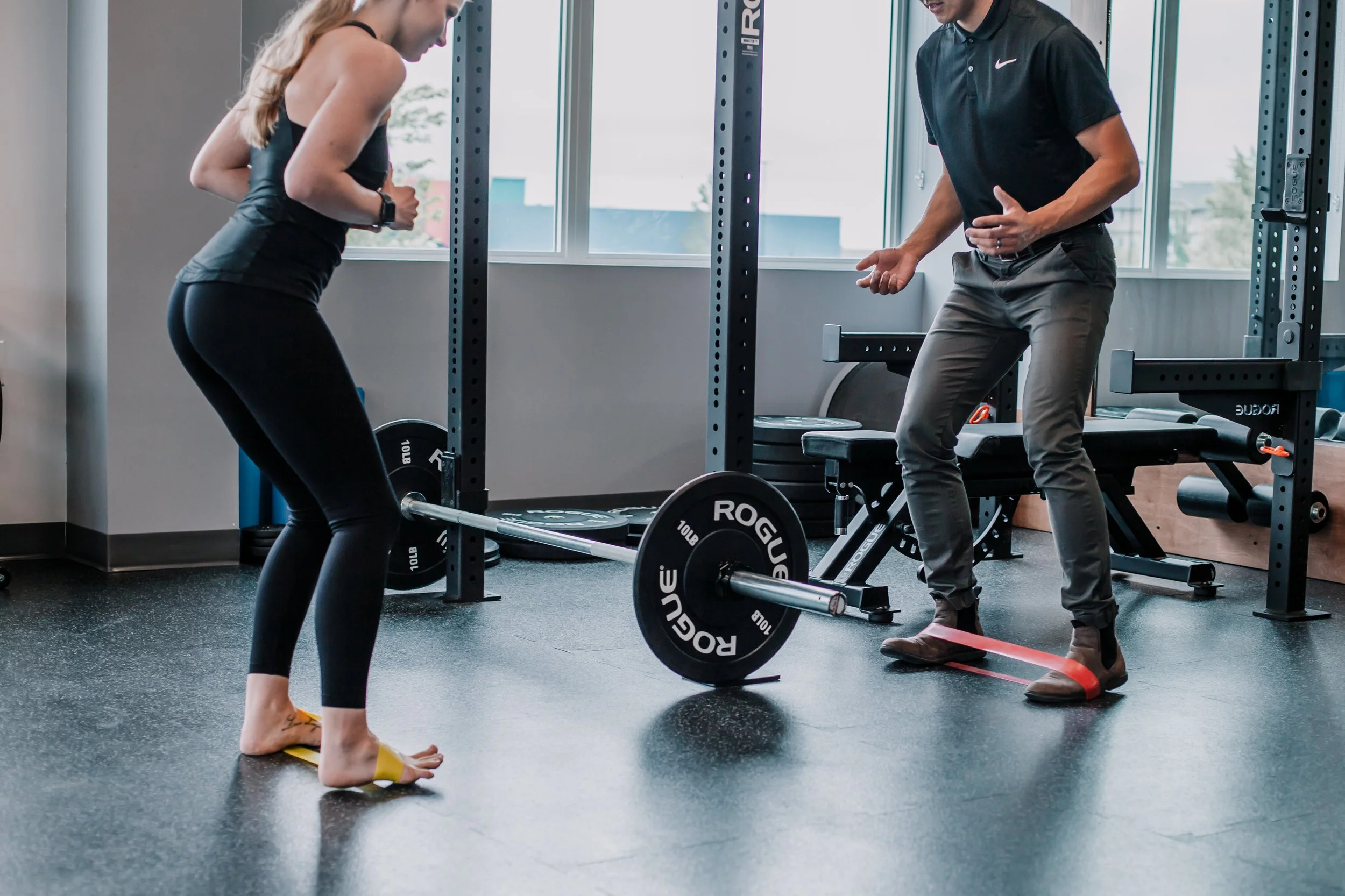
Understanding TMJ and Jaw Pain: How Can Physiotherapy Help You Find Relief
Understanding TMJ/TMD: Causes, Symptoms, and How Physiotherapy Can Help
If you’ve ever experienced persistent jaw pain, clicking sounds when chewing, or headaches that don’t seem to go away, you might be dealing with TMJ or TMD—a common but often misunderstood condition that affects millions of people.
Understanding TMJ/TMD: Causes, Symptoms, and How Physiotherapy Can Help
If you’ve ever experienced persistent jaw pain, clicking sounds when chewing, or headaches that don’t seem to go away, you might be dealing with TMJ or TMD—a common but often misunderstood condition that affects millions of people.
What Is TMJ/TMD?
TMJ stands for temporomandibular joint—the hinge that connects your jawbone to your skull. It allows you to talk, chew, and yawn. When this joint becomes irritated or dysfunctional, it leads to a condition called temporomandibular joint disorder (TMD)
TMD can cause significant discomfort and impact your daily life. It's more common than many people realize—studies suggest that 20–30% of adults experience some form of TMD.
Common Symptoms of TMJ/TMD
Recognizing the signs early is key to effective treatment. Common symptoms include:
* Jaw pain or tenderness
* Clicking, popping, or grinding noises in the jaw
* Earaches or ringing in the ears (tinnitus)
* Pain or difficulty while chewing or speaking
* Jaw locking or limited range of motion
* Headaches, facial discomfort, and neck tension
What Causes TMJ Pain or TMD?
TMD can develop due to a variety of factors, including:
* Poor posture or prolonged neck/back tension
* Bruxism (grinding or clenching your teeth, especially at night)
* Trauma or misalignment of the jaw
* Arthritis or other degenerative joint conditions
* High stress levels, which can increase jaw tension
Understanding the root cause of your symptoms is crucial to tailoring the right treatment approach.
How Physiotherapy Can Help
Physiotherapy is one of the most effective and conservative ways to manage TMJ/TMD. A trained physiotherapist will assess your jaw, neck, and overall posture to develop a personalized treatment plan. This may include:
1. Manual Therapy
Hands-on techniques that reduce joint stiffness, release tight muscles, and improve jaw alignment.
2. Therapeutic Exercises
Targeted exercises to strengthen muscles, enhance joint mobility, and correct jaw movement patterns.
3. Postural Correction
Improving posture—especially for those who sit for long hours—can significantly reduce strain on the TMJ. Your physiotherapist will recommend ergonomic changes and posture-focused exercises.
4. Pain Management Techniques
These may involve dry needling or IMS (Intramuscular Stimulation), stress reduction strategies, and patient education to manage flare-ups and prevent recurrence.
When Should You See a Physiotherapist?
If you’re experiencing:
* Jaw pain or tightness
* Clicking or popping sounds when opening or closing your mouth
* Difficulty chewing or speaking
* Reduced ability to fully open your mouth
…it may be time to consult a physiotherapist. Early intervention can help prevent chronic issues and get you back to pain-free living sooner.
Don't ignore jaw pain—your TMJ health plays a crucial role in your overall well-being. If you're struggling with symptoms of TMD, reach out to a licensed physiotherapist for a full assessment and begin your journey toward lasting relief.
The Benefits of Pelvic Physiotherapy for Men
When we hear about pelvic physiotherapy, the common assumption is that it's primarily for women. However, pelvic floor dysfunction can affect men as well, and pelvic physiotherapy offers numerous benefits for addressing these issues. In this blog post, we'll explore the importance of pelvic physiotherapy for men and how it can improve their overall health and quality of life.
When we hear about pelvic physiotherapy, the common assumption is that it's primarily for women. However, pelvic floor dysfunction can affect men as well, and pelvic physiotherapy offers numerous benefits for addressing these issues. In this blog post, we'll explore the importance of pelvic physiotherapy for men and how it can improve their overall health and quality of life.
Understanding Pelvic Floor Dysfunction in Men:
Pelvic floor dysfunction in men can manifest in various ways, including:
Urinary Incontinence: This can occur as a result of prostate surgery, neurological conditions, or pelvic floor muscle weakness.
Erectile Dysfunction: Pelvic floor muscle dysfunction can contribute to difficulties achieving or maintaining an erection.
Chronic Pelvic Pain: Conditions such as chronic prostatitis or pelvic floor tension myalgia can cause persistent pelvic pain in men.
Pelvic Organ Prolapse: While less common in men, pelvic organ prolapse can occur due to weakened pelvic floor muscles.
The Role of Pelvic Physiotherapy for Men:
Pelvic physiotherapy for men involves specialized assessment and treatment techniques aimed at addressing pelvic floor dysfunction. Some key aspects of pelvic physiotherapy for men include:
Comprehensive Assessment: A pelvic physiotherapist will conduct a thorough assessment to evaluate pelvic floor muscle function, strength, and coordination. This may involve internal palpation of the pelvic floor muscles to assess for tension, tenderness, or trigger points.
Tailored Treatment Plans: Based on the assessment findings, a personalized treatment plan will be developed to target specific pelvic floor issues. Treatment may include a combination of pelvic floor exercises, manual therapy techniques, and lifestyle modifications.
Pelvic Floor Exercises: These exercises involve contracting and relaxing the pelvic floor muscles to improve strength, endurance, and coordination.
Manual Therapy Techniques: Pelvic physiotherapists may use manual therapy techniques such as trigger point release, and internal release to address pelvic floor muscle tension and dysfunction.
Education and Lifestyle Modifications: Pelvic physiotherapists provide education on pelvic anatomy, bladder and bowel habits, posture, and breathing techniques to support pelvic floor health.
Benefits of Pelvic Physiotherapy for Men:
Improved Bladder and Bowel Control: Pelvic physiotherapy can help men regain control over bladder and bowel function, reducing symptoms of urinary incontinence and bowel dysfunction.
Enhanced Sexual Function: By addressing pelvic floor muscle dysfunction, pelvic physiotherapy can improve erectile function and sexual satisfaction in men.
Reduced Pelvic Pain: Pelvic physiotherapy techniques can help alleviate pelvic pain and discomfort, improving overall quality of life.
Prevention of Pelvic Organ Prolapse: Pelvic floor exercises and lifestyle modifications can help strengthen the pelvic floor muscles and reduce the risk of pelvic organ prolapse.
In conclusion, pelvic physiotherapy is not just for women; it offers valuable benefits for men dealing with pelvic floor dysfunction. By seeking help from a pelvic physiotherapist, men can address issues such as urinary incontinence, erectile dysfunction, chronic pelvic pain, and pelvic organ prolapse, ultimately improving their pelvic health and overall well-being.
Beyond Kegels: Pelvic Floor Physio Treatment
Pelvic floor physiotherapy is a specialized branch of physiotherapy that focuses on the assessment and treatment of pelvic floor dysfunction. While Kegel exercises are commonly associated with pelvic floor health, there are many other effective exercises and treatment modalities that pelvic floor physiotherapists utilize to address a wide range of pelvic floor issues. In this blog post, we'll explore some of these exercises and treatments, offering a comprehensive view of pelvic floor physiotherapy beyond Kegels.
Pelvic floor physiotherapy is a specialized branch of physiotherapy that focuses on the assessment and treatment of pelvic floor dysfunction. While Kegel exercises are commonly associated with pelvic floor health, there are many other effective exercises and treatment modalities that pelvic floor physiotherapists utilize to address a wide range of pelvic floor issues. In this blog post, we'll explore some of these exercises and treatments, offering a comprehensive view of pelvic floor physiotherapy beyond Kegels.
1. Pelvic Floor Relaxation Techniques:
In cases of pelvic floor hypertonicity or tightness, relaxation techniques can be highly beneficial. These techniques focus on teaching individuals how to release and relax tense pelvic floor muscles. Common relaxation techniques include diaphragmatic breathing, progressive muscle relaxation, and visualization exercises. By learning to relax the pelvic floor muscles, individuals can alleviate symptoms such as pelvic pain, urinary urgency, and constipation.
2. Pelvic Floor Strengthening Exercises:
While Kegel exercises primarily target the pelvic floor muscles, there are other exercises that can help strengthen the pelvic floor and surrounding muscles. Examples include:
Bridge Exercise: Lie on your back with knees bent and feet flat on the floor. Lift your hips off the ground, engaging your glutes and pelvic floor muscles. Hold for a few seconds, then lower back down. Repeat for several repetitions.
Squats: Stand with feet shoulder-width apart and lower into a squat position, keeping your back straight and knees aligned with your toes. As you rise back up, engage your pelvic floor muscles. Repeat for several repetitions.
Inner Thigh Squeeze: Sit on a chair with a small ball or pillow between your knees. Squeeze the ball or pillow with your inner thighs while engaging your pelvic floor muscles. Hold for a few seconds, then release. Repeat for several repetitions.
3. Manual Therapy Techniques:
Pelvic floor physiotherapists may also use manual therapy techniques to address pelvic floor dysfunction. These techniques may include:
Internal Manual Therapy: This involves the insertion of a gloved, lubricated finger into the vagina or rectum to assess and treat pelvic floor muscle tightness, trigger points, or scar tissue..
Trigger Point Release: Pressure is applied to trigger points or areas of muscular tension to alleviate pain and improve muscle function.
4. Biofeedback and Electrical Stimulation:
Biofeedback and electrical stimulation are non-invasive techniques that can help individuals improve pelvic floor muscle awareness and coordination. Biofeedback involves using sensors to provide real-time feedback on pelvic floor muscle activity, helping individuals learn to control and coordinate these muscles effectively. Electrical stimulation uses mild electrical impulses to stimulate the pelvic floor muscles, promoting muscle activation and strengthening.
In conclusion, pelvic floor physiotherapy offers a wide range of exercises and treatments beyond Kegels to address pelvic floor dysfunction effectively. Whether you're dealing with pelvic pain, urinary incontinence, or pelvic organ prolapse, a pelvic floor physiotherapist can work with you to develop a personalized treatment plan that meets your unique needs and goals. By incorporating a variety of exercises and treatments, pelvic floor physiotherapy can help individuals achieve optimal pelvic health and improve their quality of life.
Understanding the Pelvic Floor: Roles and Anatomy
The pelvic floor is a vital yet often overlooked part of the body, playing crucial roles in various functions such as supporting pelvic organs, controlling bowel and bladder movements, and contributing to sexual function. Despite its importance, many people are unfamiliar with the anatomy and functions of the pelvic floor. Let's delve into the pelvic floor's anatomy and its role in pelvic health.
The pelvic floor is a vital yet often overlooked part of the body, playing crucial roles in various functions such as supporting pelvic organs, controlling bowel and bladder movements, and contributing to sexual function. Despite its importance, many people are unfamiliar with the anatomy and functions of the pelvic floor. In this blog post, we'll delve into the pelvic floor's anatomy and its roles in maintaining pelvic health.
Anatomy of the Pelvic Floor:
The pelvic floor is a group of muscles and connective tissues that form a supportive hammock-like structure at the base of the pelvis. It consists of layers, each with its own unique function:
Superficial Layer: Contributes to sexual function and anchors the deeper muscles, and external anal sphincter
Intermediate Layer: The intermediate layer consists of the urogenital diaphragm, which supports the urethra and vagina in females and the urethra in males.
Deep Layer: The deepest layer of the pelvic floor includes the levator ani muscles, which provide structural support to the pelvic organs and help maintain continence.
Roles of the Pelvic Floor:
Supporting Pelvic Organs: One of the primary functions of the pelvic floor is to support the pelvic organs, including the bladder, uterus (in females), and rectum. These organs rest on the pelvic floor muscles, which help prevent them from descending or prolapsing into the vaginal or rectal canal.
Controlling Bowel and Bladder Movements: The pelvic floor muscles play a crucial role in maintaining bowel and bladder continence. These muscles relax to allow for the passage of urine and stool and contract to prevent leakage or incontinence.
Stabilizing the Core: The pelvic floor is an integral part of the core musculature, working in conjunction with the deep abdominal muscles, back muscles, and diaphragm to provide stability and support to the spine and pelvis.
Contributing to Sexual Function: The pelvic floor muscles are involved in sexual function and pleasure for both men and women. In females, these muscles help support the uterus and vaginal canal, while in males, they play a role in erectile function and ejaculation.
In conclusion, understanding the anatomy and roles of the pelvic floor is essential for maintaining overall health and well-being. By acknowledging the significance of the pelvic floor in supporting pelvic organs, controlling bowel and bladder movements, stabilizing the core, and contributing to sexual function, individuals can appreciate the importance of pelvic floor health in their daily lives.
Debunking Common Myths About Pelvic Health
Pelvic health is an essential aspect of overall well-being, yet it's often surrounded by misconceptions and myths that can lead to misunderstanding and unnecessary anxiety. As pelvic physiotherapists, it's crucial for us to address these misconceptions and provide accurate information to empower individuals to take control of their pelvic health. In this blog post, we'll debunk some of the most common myths about pelvic health.
Pelvic health is an essential aspect of overall well-being, yet it's often surrounded by misconceptions and myths that can lead to misunderstanding and unnecessary anxiety. As pelvic physiotherapists, it's crucial for us to address these misconceptions and provide accurate information to empower individuals to take control of their pelvic health. In this blog post, we'll debunk some of the most common myths about pelvic health.
Myth 1: Pelvic floor issues only affect women.
Fact: While it's true that women are more commonly affected by pelvic floor disorders such as urinary incontinence and pelvic organ prolapse, men can also experience pelvic floor dysfunction. Conditions like chronic prostatitis and erectile dysfunction can be related to pelvic floor muscle dysfunction in men. Therefore, both men and women should be aware of their pelvic health and seek appropriate care if needed.
Myth 2: Pelvic floor exercises are only for women who have given birth.
Fact: Pelvic floor exercises can help strengthen the pelvic floor muscles, improve bladder and bowel control, and enhance sexual function. Women who have not given birth can still experience pelvic floor dysfunction. Men can also benefit from pelvic floor exercises to address issues like erectile dysfunction and chronic pelvic pain.
Myth 3: Pelvic pain is normal and something you have to live with.
Fact: While pelvic pain is common, especially among women, it is not normal, and it shouldn't be ignored. Chronic pelvic pain can be a sign of underlying conditions such as endometriosis, pelvic inflammatory disease, or pelvic floor dysfunction. Seeking help from a pelvic health physiotherapist can assist in management of symptoms.
Myth 4: Surgery is the only option for pelvic organ prolapse.
Fact: Surgery is one treatment option for pelvic organ prolapse, but it's not the only one. Pelvic floor physiotherapy, including pelvic floor exercises, lifestyle modifications, and pessary use, can also be effective in managing pelvic organ prolapse, especially in mild to moderate cases. Surgery should be considered only after conservative treatments have been explored and failed to provide adequate relief.
Myth 5: You don't need to see a pelvic health physiotherapist unless you have a specific problem.
Fact: Just like you see a dentist for regular dental check-ups, it's essential to prioritize your pelvic health by seeing a pelvic health physiotherapist for preventive care and maintenance. Pelvic health physiotherapists can assess your pelvic floor function, provide personalized exercise programs, and offer guidance on lifestyle modifications to prevent pelvic floor issues from developing or worsening over time. It is also a great idea to visit a pelvic health physiotherapist if you are planning for pregnancy or are currently pregnant.
In conclusion, understanding the facts about pelvic health is crucial for maintaining overall well-being. By debunking common myths and misconceptions, we can empower individuals to take proactive steps towards optimizing their pelvic health. If you have any concerns about your pelvic health, don't hesitate to reach out to a pelvic health physiotherapist for guidance and support.
Running Strong: The Crucial Role of Physiotherapy for Runners
Whether you're a seasoned marathoner or a casual jogger, the exhilaration of pounding the pavement is unmatched. However, the repetitive impact of running can take a toll on your body, leading to a myriad of issues ranging from minor discomfort to serious injuries. This is where physiotherapy becomes a runner's best ally, playing a pivotal role in preventing injuries, enhancing performance, and ensuring a long and healthy running journey.
Whether you're a seasoned marathoner or a casual jogger, the exhilaration of pounding the pavement is unmatched. However, the repetitive impact of running can take a toll on your body, leading to a myriad of issues ranging from minor discomfort to serious injuries. This is where physiotherapy becomes a runner's best ally, playing a pivotal role in preventing injuries, enhancing performance, and ensuring a long and healthy running journey.
Injury Prevention: One of the primary benefits of physiotherapy for runners is injury prevention. Physiotherapists assess your biomechanics, gait, and muscle imbalances to identify potential issues before they escalate. By addressing weaknesses and imbalances through targeted exercises and stretching, physiotherapy helps runners correct their form and reduce the risk of common injuries like shin splints, stress fractures, and IT band syndrome.
Customized Rehabilitation Programs: In the unfortunate event of an injury, physiotherapy plays a crucial role in the rehabilitation process. Physiotherapists develop personalized treatment plans to accelerate healing, restore mobility, and strengthen weakened muscles. This tailored approach ensures that runners can return to the road with confidence, minimizing the risk of recurrent injuries.
Optimizing Performance: Beyond injury prevention and rehabilitation, physiotherapy contributes to optimizing running performance. By focusing on strength, flexibility, and mobility, physiotherapists help runners improve their overall fitness and efficiency. Enhanced muscle function and joint mobility translate into better running mechanics, enabling runners to cover more ground with less effort.
Pain Management: Runners often experience aches and pains, especially as mileage increases. Physiotherapy offers effective pain management strategies, combining hands-on techniques with therapeutic exercises. This not only alleviates immediate discomfort but also addresses the root causes, ensuring long-term relief and a more enjoyable running experience.
In the dynamic world of running, physiotherapy emerges as a cornerstone for longevity and success. Whether you're aiming for a personal best or simply enjoying the therapeutic benefits of running, incorporating physiotherapy into your routine is a proactive step toward a healthier, injury-free journey. By partnering with a physiotherapist, runners can unlock their full potential, running stronger, faster, and with greater resilience. Remember, it's not just about the miles you run but how well you take care of the body that propels you forward. Prioritize physiotherapy, and let every step be a testament to your commitment to a lifelong running passion.
What is Pelvic Floor Therapy?
Have you ever dealt with the troubling issue of not being able to control your bladder? Have you ever thought about finding relief from pain during sex or using a tampon? Maybe you have been diagnosed with a condition where organs in your pelvis drop, causing a lot of symptoms, but you aren't a candidate for surgery. Don't worry, because there is hope. Pelvic floor therapy is a form of rehab that can help with these problems and more, offering a real treatment option for those who don't seem to have any other options. See how our team at Bloom Therapy can help.
Have you ever dealt with the troubling issue of not being able to control your bladder? Have you ever thought about finding relief from pain during sex or using a tampon? Maybe you have been diagnosed with a condition where organs in your pelvis drop, causing a lot of symptoms, but you aren't a candidate for surgery. Don't worry, because there is hope. Pelvic floor therapy is a form of rehab that can help with these problems and more, offering a real treatment option for those who don't seem to have any other options.
Still not clear? Let’s back it up a step.
Pelvic floor therapy is a branch of Physiotherapy that is offered by a physiotherapist who has completed the necessary education to assess, diagnosis and treat pelvic floor conditions and disorders. Not every physiotherapist is a pelvic therapist but every pelvic therapist is a certified physiotherapist.
The awareness around this area of practice has been steadily increasing as a greater number of women and men seek alternative care for their pelvic health concerns.
Pelvic therapy is a specialized form of therapy that focuses on addressing various pelvic concerns, such as incontinence, prolapse, and pain during sex. However, it is important to note that pelvic therapy can also be beneficial for individuals experiencing chronic back or hip pain that has not responded well to traditional physiotherapy methods. Pelvic physiotherapists are often knowledgeable about pregnancy-related conditions like rectus diastasis and pelvic girdle pain as well. The scope of pelvic floor therapy extends beyond these examples, so if you're unsure whether pelvic therapy is right for you, I recommend scheduling a discovery call with a pelvic therapist of your choice. This will help you determine if pelvic therapy is the appropriate fit for your specific needs.
So what can you expect in pelvic floor therapy treatment?
At Bloom Therapy, we understand the importance of clear communication and setting expectations with our clients. When it comes to the assessment and treatment of pelvic floor conditions, we prioritize a thorough understanding of the condition as a whole. Our skilled therapists have specialized knowledge surrounding pelvic floor conditions and utilize a systemic/whole body assessment approach to identify the underlying factors contributing to the issue. This approach allows us to determine the driving cause and develop a targeted treatment plan.
During the assessment process, an internal examination may be performed to determine if the pelvic floor muscles are involved in the problem. We want to assure our clients that this examination is not always required and can be opted out of at any time, based on their level of comfort. We value your autonomy and respect your boundaries.
Following the evaluation, our therapists will provide treatment and develop a home exercise program based on the findings and the individualized treatment plan. This comprehensive approach ensures that our clients receive the most effective and personalized care possible.
At Bloom Therapy, we prioritize transparency and empowering our clients to make informed decisions about their treatment. We believe in open communication and will always provide clear explanations, answer any questions, and address any concerns our clients may have. Together, we will work towards achieving the best possible outcomes and improving overall well-being.
Bottom line?
If you are struggling with pelvic floor concerns, pelvic therapy should be considered as a first line of treatment. Remember, just because it is common, does not mean it’s normal.
- Miranda Shumborski, MScPT
The Top 5 Ways Physiotherapy Can Help with Concussions
Check out the top 5 ways your Bloom Therapy Physiotherapist can facilitate your concussion recovery.
If you read our last post on concussions, you may want to dive a little deeper into how Physiotherapy can help.
Here are the top 5 ways your Physiotherapist can facilitate your recovery.
1. Vestibular Rehabilitation:
One of the commonly affected systems after a concussion is the vestibular system, which is responsible for our sense of balance and spatial orientation. Physiotherapists trained in vestibular rehabilitation can assess and treat these impairments. They can use specific exercises and techniques to help lessen dizziness, improve balance, and restore optimal function to the vestibular system.
2. Visual Rehabilitation:
Concussions can also disrupt the visual system, leading to issues such as blurred vision, double vision, difficulties with eye coordination, or trouble focusing. Physiotherapists who specialize in visual rehabilitation can design personalized exercises and therapies that target these visual disturbances. By improving eye movement control, focusing abilities, and visual processing speed, individuals can regain their visual function and alleviate associated symptoms.
3. Return-to-Play Assessment and Training:
For athletes recovering from concussions, an important goal is to safely return to their sport. Physiotherapists with expertise in sports-specific training can conduct comprehensive assessments to determine an individual's readiness to return to play. They can develop specialized training programs that gradually reintroduce physical activity, focusing on improving strength, endurance, agility, and balance. This approach ensures a safe and successful return to sport without risking re-injury.
4. Neck and Head Pain Management:
Concussions often result in neck and head pain, which can significantly impact an individual's quality of life. Physiotherapy interventions, such as manual therapy, therapeutic exercises, and cervical spine mobilizations, can help alleviate pain and restore normal neck function. By addressing these issues, physiotherapists can improve the overall well-being of individuals during their concussion recovery.
5. Education and Symptom Management:
An integral part of physiotherapy for concussions involves patient education and symptom management. Physiotherapists can provide guidance on energy conservation strategies, sleep hygiene practices, and relaxation techniques. They also teach individuals how to manage their symptoms effectively and monitor their progress throughout the recovery process.
Conclusion:
Physiotherapy is a vital component of concussion management and recovery. By addressing specific impairments and symptoms associated with concussions, physiotherapists can help individuals regain their day-to-day functioning and safely return to their regular activities, including sports. If you or a loved one have suffered a concussion, seeking the guidance and expertise of a physiotherapist can make a significant difference in the recovery journey. Remember, a thorough assessment and an individualized treatment plan can go a long way toward a successful recovery from concussions.
Concussion- How Physio Can Help!
What is a concussion?
Concussions are a type of traumatic brain injury that are typically sustained due to direct impacts to the head or body, including a whiplash type motion. It occurs when the axons on nerves in the brain shear back and forth, causing electrical signals to be scattered all over the brain. This creates an electrical storm of activity and energy, leading to an energy depletion, which is where the lasting symptoms often come from.
What is a concussion?
Concussions are a type of traumatic brain injury that are typically sustained due to direct impacts to the head or body, including a whiplash type motion. It occurs when the axons on nerves in the brain shear back and forth, causing electrical signals to be scattered all over the brain. This creates an electrical storm of activity and energy, leading to an energy depletion, which is where the lasting symptoms often come from.
Common symptoms include:
Headaches
Neck pain
Nausea or vomiting
Dizziness
Blurred vision
Balance problems
Sensitivity to light or noise
Difficulty with cognitive activity- concentrating, memory
Difficulty falling asleep
Emotional symptoms- more irritable, nervous, or sad
Symptom exacerbation generally peaks around the 3-5 day mark, however energy stores are not fully restored until 3-4 weeks.
It is important to seek help from a qualified rehab professional when you are recovering from a concussion to ensure that these energy levels have been restored to their pre-injury level and to prevent a second more dangerous hit to the head when the brain is not functioning at full capacity.
A physiotherapy concussion assessment will include assessment of the visual and vestibular systems through an exam of eye and head movement and balance. We also look at the neck, as most concussions occur alongside whiplash or a neck strain. At the next visit, we do a walking test on the treadmill to find if a specific heart rate increases concussion symptoms. It is common that an increase in metabolic demands increases symptoms due to the brain operating in a lower energy state.
For any tests that are found positive, or areas of the brain that bring on symptoms, we prescribe homework at a level that prevents a large increase in symptoms but allows the body to begin to adapt and return to baseline. Just like a muscle strain, we want to slowly reload and challenge the system to adapt and heal!
If you think you may have sustained a concussion, book in for a concussion assessment today.
-Ashley Ouellette, MScPT
Feeling Dizzy?
Are you experiencing episodes of vertigo or the sensation of the room spinning? Benign paroxysmal positional vertigo, or BPPV for short is a disorder of the inner ear and is the most common cause of peripheral related vertigo. Vertigo is a complex and disabling condition that affects millions of individuals worldwide. Characterized by a false sense of spinning or movement, it can cause severe dizziness, nausea, and disorientation.
Are you experiencing episodes of vertigo or the sensation of the room spinning? Benign paroxysmal positional vertigo, or BPPV for short is a disorder of the inner ear and is the most common cause of peripheral related vertigo. Vertigo is a complex and disabling condition that affects millions of individuals worldwide. Characterized by a false sense of spinning or movement, it can cause severe dizziness, nausea, and disorientation.
BPPV occurs when crystals in the inner ear become displaced and end up in the semicircular canals, this creates a mismatch in signals and the illusion of vertigo. These vertigo episodes are triggered by movements of the head, and are relatively short in duration, lasting up to a minute. Symptoms can last weeks to months. This condition can have a significant impact on a person's daily life, often leading to difficulties with balance, coordination, and even anxiety or depression.
BPPV primarily affects those over 50 years old, but may occur in any age group, particularly when following a head trauma. The cause of BPPV is unknown, however preceding events such as head traumas, vestibular neuritis, or conditions which affect the vestibular system may contribute.
A physiotherapist or chiropractor can assess and treat BPPV. Diagnosis is made from a clinical history, positional testing with observation of eye movements, and by ruling out other causes. If BPPV is diagnosed your provider can perform positional maneuvers of the head specific to the canal involved to treat the vertigo. Additional assessment of the visual and balance systems can be beneficial to identify any lingering symptoms and can often be treated with vestibular rehabilitation exercises.
If you think you may be suffering from or have been diagnosed with BPPV, book in for a physiotherapy or chiropractic assessment.
- Sidney Wideman, MScPT
Experience the difference… but what is the difference?
Have you ever gone for physiotherapy and your therapist was treating two or three other people at the same time? You spend an hour at the clinic but maybe get 15 minutes of one-on-one time with the therapist – the rest of the time is spent on hot packs, TENS machines, and doing exercises in a curtained-off room by yourself.
Have you ever gone for physiotherapy and your therapist was treating two or three other people at the same time? You spend an hour at the clinic but maybe get 15 minutes of one-on-one time with the therapist – the rest of the time is spent on hot packs, TENS machines, and doing exercises in a curtained-off room by yourself.
If this sounds all too familiar, sadly you are not alone. It is a typical treatment model in the world of physiotherapy. Unfortunately, it is one of the reasons people shy away from physiotherapy when they get injured or need rehabilitation for their aches and pains.
At Bloom Therapy, our treatment model is a truly one-on-one experience. That means from start to finish, your time in clinic is spent entirely with your physiotherapist to address your needs. The extra time with your therapist will allow them to educate you on the issue, develop a treatment plan, and execute that plan in an unrushed environment.
If you’re looking for a change from the traditional clinic model, we’d love to show you the difference.
- Thanh Tang, MScPT











